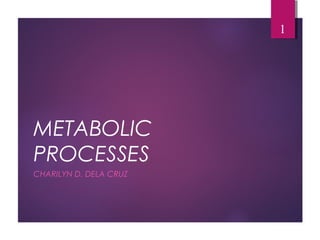
METABOLIC PROCESSES IN 40 CHARACTERS
- 1. METABOLIC PROCESSES CHARILYN D. DELA CRUZ 1
- 2. Introduction 2 • Metabolic processes – all chemical reactions that occur in the body There are two (2) types of metabolic reactions: • Anabolism • Larger molecules are made from smaller ones • Requires energy • Catabolism • Larger molecules are broken down into smaller ones • Releases energy
- 3. Anabolism 3 • Anabolism provides the materials needed for cellular growth and repair • Dehydration synthesis • Type of anabolic process • Used to make polysaccharides, triglycerides, and proteins • Produces water CH2OH H H OH O H OH Monosaccharide + HHO H OH H H OH O H OH Monosaccharide HHO H OH H H OH O H OH Disaccharide H2O Water+ HHO H H H OH O H OH HO H OH Copyright © The McGraw-Hill Companies, Inc. Permission required for reproduction or display. CH2OH CH2OH CH2OH
- 4. Amino acid N H H C C H R Dipeptide molecule ++ Peptide bond Amino acid N H H C C H H H R H O N H H C C H R H O N H C C OH R H O O N H H C C H R N H C C OH R H O O Water Copyright © The McGraw-Hill Companies, Inc. Permission required for reproduction or display. O O H2O Anabolism 4 H C H Glycerol 3 fatty acid molecules+ OH HO H C OH HO H C C C COH HO H O O C C C O O O H C H Fat molecule (triglyceride) + H C H C O O O H 3 water molecules (CH2)14 CH3 (CH2)14 CH3 (CH2)14 CH3 (CH2)14 CH3 (CH2)14 CH3 (CH2)14 CH3 H2O H2O H2O Copyright © The McGraw-Hill Companies, Inc. Permission required for reproduction or display. O
- 5. Catabolism 5 • Catabolism breaks down larger molecules into smaller ones • Hydrolysis • A catabolic process • Used to decompose carbohydrates, lipids, and proteins • Water is used to split the substances • Reverse of dehydration synthesis CH2OH H H OH O H OH Monosaccharide + HHO H OH H H OH O H OH Monosaccharide HHO H OH H H OH O H OH Disaccharide H2O Water+ HHO H H H OH O H OH HO H OH Copyright © The McGraw-Hill Companies, Inc. Permission required for reproduction or display. CH2OH CH2OH CH2OH
- 6. Catabolism 6 Amino acid N H H C C H R Dipeptide molecule ++ Peptide bond Amino acid N H H C C H H H R H O N H H C C H R H O N H C C OH R H O O N H H C C H R N H C C OH R H O O Water Copyright © The McGraw-Hill Companies, Inc. Permission required for reproduction or display. O O H2O H C H Glycerol 3 fatty acid molecules+ OH HO H C OH HO H C C C COH HO H O O C C C O O O H C H Fat molecule (triglyceride) + H C H C O O O H 3 water molecules (CH2)14 CH3 (CH2)14 CH3 (CH2)14 CH3 (CH2)14 CH3 (CH2)14 CH3 (CH2)14 CH3 H2O H2O H2O Copyright © The McGraw-Hill Companies, Inc. Permission required for reproduction or display. O
- 7. Control of Metabolic Reactions 7 • Enzymes • Control rates of metabolic reactions • Lower activation energy needed to start reactions • Most are globular proteins with specific shapes • Not consumed in chemical reactions • Substrate specific • Shape of active site determines substrate Product molecule Active site (a) (b) (c) Substrate molecules Unaltered enzyme molecule Enzyme-substrate complex Enzyme molecule Copyright © The McGraw-Hill Companies, Inc. Permission required for reproduction or display.
- 8. 8 Enzymes are globular proteins that promote chemical reactions by lowering the activation energy required to start the reaction and enhancing the reaction rate. They are catalysts that do not get chemically changed in the reaction themselves . Since they are not consumed by the reaction, they are needed only in very small quantities. Enzymes are specific and act only on particular substrates. There are enzymes that make bonds and synthesize molecules and there are those enzymes that break bonds and degrade molecules into smaller molecules.
- 9. Enzyme Action 9 • Metabolic pathways • Series of enzyme-controlled reactions leading to formation of a product • Each new substrate is the product of the previous reaction • Enzyme names commonly: • Reflect the substrate • Have the suffix – ase • Examples: sucrase, lactase, protease, lipase Substrate 1 Enzyme A Substrate 2 Enzyme B Substrate 3 Enzyme C Substrate 4 Enzyme D Product Copyright © The McGraw-Hill Companies, Inc. Permission required for reproduction or display.
- 10. Cofactors and Coenzymes 10 • Cofactors • Make some enzymes active • Non-protein component • Organic Ions or coenzymes such as zinc, copper, calcium, or iron. • Coenzymes • Organic molecules that act as cofactors • Small organic molecules that are often vitamins or derived from vitamins. Enzymes are often inactive until combining with cofactors or coenzymes.
- 11. Factors That Alter Enzymes 11 • Factors that alter enzymes: • Heat • Radiation • Electricity • Chemicals • Changes in pH
- 12. Regulation of Metabolic Pathways 12 • Limited number of regulatory enzymes • Negative feedback Inhibition Substrate 1 Substrate 2 Enzyme B Substrate 3 Enzyme C Substrate 4 Enzyme D Product Rate-limiting Enzyme A Copyright © The McGraw-Hill Companies, Inc. Permission required for reproduction or display.
- 13. 13 Important Points in Chapter 4: Outcomes to be Assessed 4.1: Introduction Define metabolism. Explain why protein synthesis is important. 4.2: Metabolic Processes Compare and contrast anabolism and catabolism. Define dehydration synthesis and hydrolysis. 4.3: Control of Metabolic Reactions Describe how enzymes control metabolic reactions. List the basic steps of an enzyme-catalyzed reaction. Define active site.
